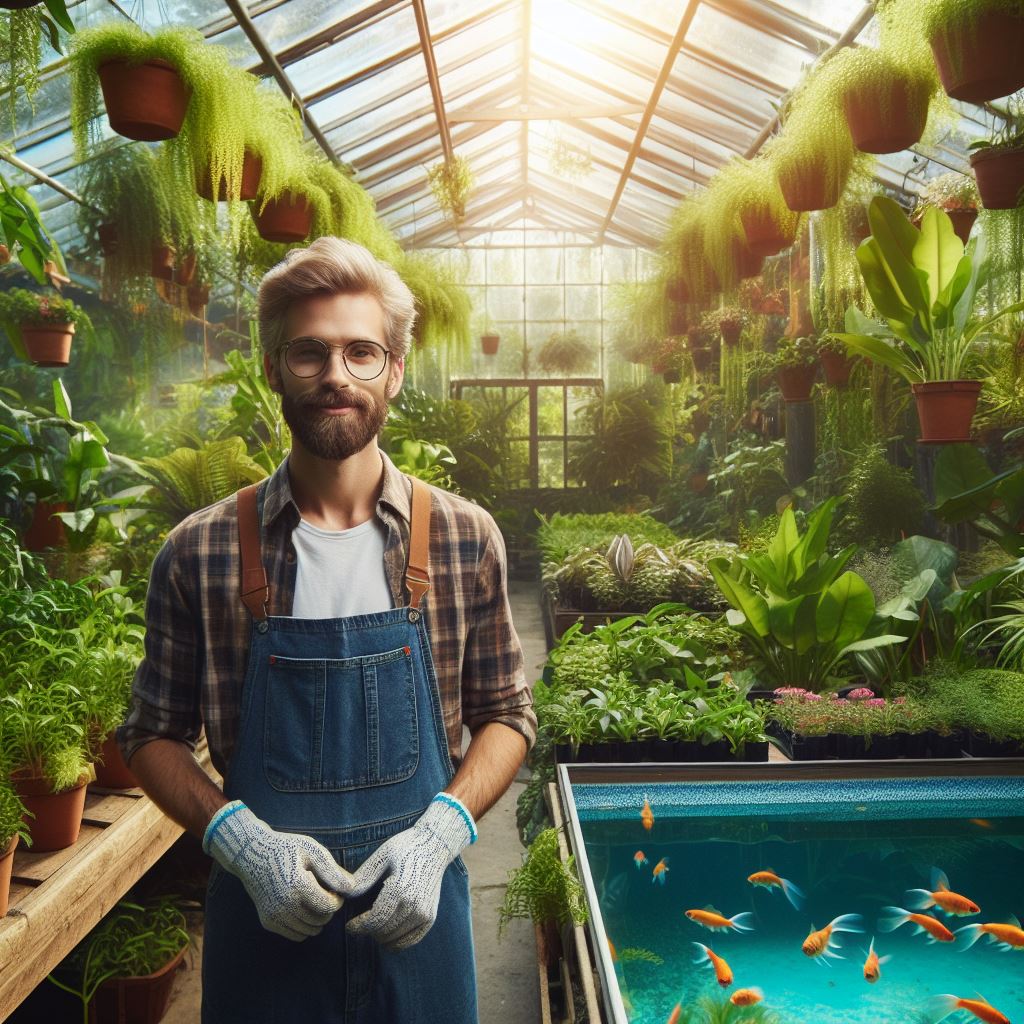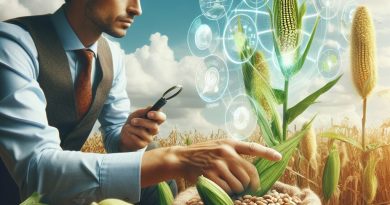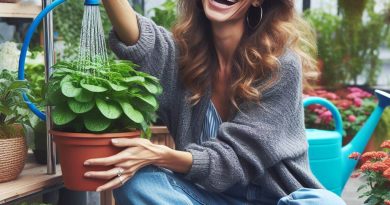Fish-Powered Gardens: Aquaponics Guide
Last Updated on March 2, 2024
Introduction
Aquaponics is an innovative system that merges fish farming with hydroponics, creating a mutually beneficial relationship between fish and plants.
This method ensures optimal plant growth while maintaining a thriving fish population.
Sustainable gardening methods are vital for reducing water consumption and eliminating chemical fertilizers and pesticides, ensuring the long-term health of both plants and the planet.
Fish-powered gardens provide an effective solution as they recycle water and nutrients, reducing waste and conserving resources.
In this type of garden, fish waste acts as a natural fertilizer for plants.
The waste is broken down into essential nutrients that nourish the plants, while the plants filter the water, keeping it clean and safe for the fish.
This eliminates the need for synthetic fertilizers or harmful chemicals.
Moreover, the constant circulation of water and nutrients in the system promotes faster plant growth and healthier root development.
Fish-powered gardens offer several advantages.
Firstly, they are highly efficient, using up to 90% less water compared to traditional soil-based gardening.
Secondly, the system is self-sustaining, reducing the need for constant monitoring and maintenance.
Additionally, the plants and fish in the system can be grown for both food production and aesthetic purposes, making it a versatile gardening method.
Finally, aquaponics gardens can be set up in various locations, including urban areas with limited space, allowing individuals to grow their own fresh produce even in a small backyard or balcony.
Basically, aquaponics is a sustainable gardening method that combines fish farming and hydroponics.
Fish-powered gardens offer multiple benefits such as water conservation, self-sustainability, and versatility.
Incorporating this method into gardening practices can promote a more eco-friendly and efficient way of growing plants and raising fish.
The Basics of Aquaponics
A. Definition of aquaponics
Aquaponics is a sustainable farming method that combines aquaculture and hydroponics in a symbiotic system.
It involves growing plants and raising fish together in a closed-loop ecosystem.
B. How aquaponics combines fish farming and hydroponics
In aquaponics, fish waste provides nutrients for the plants, and the plants filter and clean the water for the fish.
Fish produce ammonia-rich waste, which is converted to nitrates by beneficial bacteria for plant consumption.
The plants, in turn, absorb these nitrates as their nutrient source.
C. The symbiotic relationship between fish and plants in the system
The fish excrete waste containing ammonia into the water, which would become toxic if left untreated.
However, in aquaponics, this waste becomes an essential nutrient for the plants.
Beneficial bacteria in the system convert ammonia to nitrites and then to nitrates, which are easily absorbed by plants.
This natural filtration process creates a balanced ecosystem where both fish and plants thrive.
Advantages of Aquaponics
- Efficient resource utilization: Aquaponics uses 90% less water compared to traditional soil-based farming.
- Higher crop yields: Plants grow faster and yield more abundant produce due to optimal nutrient availability.
- Year-round production: Aquaponics can be practiced indoors, allowing for continuous harvest regardless of weather conditions.
- Reduced dependency on fertilizers: The fish waste provides all the necessary nutrients, eliminating the need for synthetic fertilizers.
- No chemical pesticides: The closed-loop system reduces the risk of pests and diseases, minimizing the need for chemical pesticides.
Challenges and Considerations
- Initial setup cost: Aquaponics systems can be expensive to set up, requiring investment in equipment and infrastructure.
- Technical knowledge: A certain level of understanding is needed to maintain water quality, monitor fish health, and manage the system.
- Species selection: Choosing fish and plant species that are compatible and suitable for the local climate is crucial.
- System maintenance: Regular monitoring of water parameters, pH levels, and nutrient balance is necessary for system stability.
- Limited fish options: Not all fish are suitable for aquaponics; specific species like tilapia, trout, or catfish are commonly used.
Aquaponics offers a sustainable and efficient method of food production that benefits both the environment and consumers.
By harnessing the symbiotic relationship between fish and plants, this system provides a continuous supply of fresh produce while minimizing resource consumption and reducing the reliance on harmful chemicals.
Despite its challenges, aquaponics has the potential to revolutionize farming practices and contribute to a more sustainable future.
Read: Hydroponics vs. Soil: What’s Best for You?
Setting Up Your Fish-Powered Garden
A. Choosing the Right Type of Fish for Aquaponics
- Research various fish species suitable for aquaponics based on your climatic conditions.
- Consider factors such as temperature tolerance, growth rate, and compatibility with plants.
- Avoid carnivorous fish that could eat smaller fish or disrupt the ecosystem.
- Popular choices include tilapia, catfish, trout, carp, and perch, depending on your region.
B. Selecting an Appropriate Tank or Pond for the Fish
- Assess your available space and budget to determine the size and type of tank or pond.
- Choose a tank or pond that provides enough space for the fish to swim and grow comfortably.
- Consider the material of the tank or pond, ensuring it is safe for the fish and plants.
- Install a secure cover or netting to prevent predators or birds from accessing the fish.
C. Considerations for the Location of the Garden
- Find a location with ample sunlight exposure for the plants while considering shade for the fish.
- Ensure your garden is easily accessible for monitoring, maintenance, and harvesting.
- Avoid areas prone to extreme temperature fluctuations, such as near air vents or heaters.
- Plan for a stable ground or foundation that can support the weight of the tank or pond.
D. Essentials for Maintaining Water Quality in the System
- Monitor water pH regularly to ensure it remains within the optimal range for both fish and plants.
- Invest in a reliable water testing kit to regularly check for ammonia, nitrite, and nitrate levels.
- Use an efficient filtration system to remove solid waste and maintain water clarity.
- Consider adding aeration devices, such as air stones or pumps, to ensure proper oxygen levels.
- Regularly conduct partial water changes to replenish nutrients and remove excessive waste buildup.
Setting up your fish-powered garden requires careful consideration of the fish species, suitable tanks, location, and water quality.
By making informed choices and implementing proper maintenance, you can create a thriving and sustainable aquaponics system.
Read: Water Works: Basics of Home Aquaponics
Creating the Plant Growing Area
A. Overview of the hydroponic component of aquaponics
Aquaponics combines aquaculture and hydroponics, utilizing fish waste to fertilize plants grown in water.
In aquaponics, the hydroponic component plays a crucial role in creating the ideal environment for plant growth.
B. Different types of hydroponic systems suitable for fish-powered gardens
- Nutrient Film Technique (NFT): A thin film of nutrient-rich water flows over plant roots, providing constant nourishment.
- Deep Water Culture (DWC): Plants float on rafts in a pond of nutrient-infused water, with their roots submerged.
- Vertical Towers: Stacking containers allow plants to grow vertically, maximizing space utilization.
- Aeroponics: Plants receive a nutrient mist rather than water, promoting rapid and efficient growth.
Various hydroponic systems can be used, depending on the available space and plant varieties desired.
Nutrient-rich water from the fish tanks is circulated through the hydroponic system, providing the plants with the necessary nutrients.
The Nutrient Film Technique (NFT) allows a thin film of water to constantly flow over plant roots, offering a constant supply of nutrients.
Deep Water Culture (DWC) involves floating plants on rafts in a pond of nutrient-infused water.
Vertical towers provide a space-saving solution, allowing plants to grow vertically.
Aeroponics, on the other hand, mists plants’ roots with nutrients, promoting rapid growth.
C. Selecting the right plants for aquaponics and their requirements
- Leafy Greens: Lettuce, kale, and spinach thrive in aquaponic systems, requiring nutrient-rich water and mild temperatures.
- Herbs: Basil, mint, and parsley are excellent choices, preferring slightly acidic conditions and moderate light.
- Fruit-bearing Plants: Tomatoes, peppers, and strawberries can be grown successfully, needing ample sunlight and nutrients.
Choosing the right plants for aquaponics is essential for a successful system.
Leafy greens like lettuce and kale, which thrive in nutrient-rich water and mild temperatures, are excellent choices.
Herbs such as basil and mint prefer slightly acidic conditions and moderate light.
Fruit-bearing plants like tomatoes and peppers require ample sunlight and nutrients to develop their fruits.
D. Tips for maximizing plant growth and yield in aquaponic systems
- Optimal pH levels: Maintain a pH between 6.8 and 7.2 for optimal nutrient absorption by plants.
- Adequate lighting: Supplement natural light with grow lights to ensure plants receive sufficient light for photosynthesis.
- Nutrient monitoring and supplementation: Regularly test water quality and add necessary supplements to maintain ideal nutrient levels.
- Plant spacing: Allow enough space between plants to prevent overcrowding and ensure proper airflow.
- Pest prevention: Implement measures to keep pests at bay, such as introducing beneficial insects or using organic pest control methods.
- Timely harvesting: Harvest crops at their peak to encourage continuous growth and maximize yield.
To maximize plant growth and yield in aquaponic systems, several factors should be considered.
Maintaining the optimal pH level between 6.8 and 7.2 ensures plants can absorb nutrients effectively.
Supplementing natural light with grow lights helps plants receive sufficient light for photosynthesis, especially in indoor setups.
Regularly testing water quality and adding necessary supplements ensures plants receive the right nutrients.
Proper plant spacing prevents overcrowding and allows for proper airflow, reducing the risk of disease and promoting healthy growth.
Implementing pest prevention measures, such as introducing beneficial insects or using organic pest control methods, helps protect plants from pests and diseases.
Additionally, harvesting crops at their peak encourages continuous growth and maximizes yield.
Essentially, creating the plant growing area in aquaponics involves understanding different hydroponic systems, selecting suitable plants, and implementing strategies for optimal growth.
By providing the right conditions and nutrients, fish-powered gardens can thrive with bountiful produce and a symbiotic relationship between fish and plants.
Read: Grow More: Vertical Hydroponic Solutions

Managing the Fish and Plant Growth
Aquaponics systems require careful monitoring and management to ensure optimal growth of both fish and plants.
A. Monitoring and maintaining proper water parameters
Regularly test and monitor water pH, ammonia, nitrite, and nitrate levels to maintain a stable environment for the fish and plants.
Keep the pH level between 6.8 and 7.2 to ensure fish health and nutrient uptake by the plants.
Control ammonia levels by avoiding overfeeding and periodically adding beneficial bacteria to break down ammonia into nitrites.
Nitrite levels should be kept below 0.5 ppm to prevent stress or death in fish.
Nitrate levels should stay below 80 ppm to prevent excessive plant growth and subsequent nutrient imbalances.
B. Feeding and caring for the fish in aquaponics
Choose appropriate fish species that can thrive in aquaponic systems such as tilapia, trout, or koi.
Feed the fish a high-quality balanced diet that meets their nutritional requirements and does not overfeed.
Monitor fish behavior and adjust feeding accordingly, ensuring no uneaten food is left in the system.
Regularly check the fish for any signs of stress or disease, as early detection helps prevent widespread problems.
Ensure adequate oxygen levels in the water by using aeration devices or providing air stones to prevent oxygen depletion.
C. How to prevent and manage common fish diseases
Maintain good water quality to prevent stress and disease outbreaks in fish.
Quarantine new fish before introducing them to the aquaponics system to prevent the spread of diseases.
Regularly observe the fish for any signs of illness, such as changes in behavior, appetite, or physical appearance.
If diseases occur, consult a veterinarian experienced in aquatic animals for proper diagnosis and treatment.
Follow appropriate treatment protocols and quarantine infected fish to minimize the risk to the rest of the population.
D. Pruning, harvesting, and maintaining the plants in the garden
Regularly prune and thin out plants to ensure adequate airflow and light penetration.
Harvest mature and ready-to-use plant parts regularly to encourage continuous growth and prevent overcrowding.
Monitor plants for any signs of pests or diseases and take appropriate measures to prevent their spread.
Provide sufficient nutrients to the plants through a balanced fish waste-to-nutrient conversion process.
Regularly clean and maintain the grow beds, removing any debris or dead plant matter to prevent nutrient imbalances.
In general, managing fish and plant growth in an aquaponics system requires diligent care and attention.
Proper monitoring of water parameters, feeding fish appropriately, preventing and managing diseases, and maintaining plants are essential for a thriving and productive fish-powered garden.
Read: Urban Farming: Aquaponics in the City
You Might Also Like: Natural Fungicides for Your Garden
Troubleshooting and Problem-Solving
A. Identifying and resolving common issues in aquaponics systems
When operating an aquaponics system, it’s essential to be tuned in to potential problems that may arise.
Here are some common issues and their solutions:
- Low or fluctuating pH levels can be a sign of inadequate buffering capacity. Adding crushed coral or oyster shell can help stabilize pH levels.
- If your plants are not growing as expected, it could be due to insufficient lighting. Consider installing supplemental grow lights.
- Water temperature extremes can stress both fish and plants. Use a heater or chiller to maintain optimal water temperatures.
- If you notice poor water circulation or oxygenation, check if your pumps and aeration systems are working correctly.
B. Addressing nutrient deficiencies and imbalances
Nutrient deficiencies or imbalances can hinder plant growth and affect the overall health of your aquaponics system.
Here’s how to tackle them:
- Yellowing leaves may indicate a lack of nitrogen. Adding fish waste or a nitrogen-based fertilizer can rectify this issue.
- Pale leaves or stunted growth may indicate a potassium deficiency. Adding a potassium supplement or ensuring sufficient fish feed can help.
- Calcium deficiency can show up as curled or distorted leaves. Crushed eggshells or dolomite can supply the needed calcium for your plants.
- If your plants exhibit a general decline in health, it may be due to a lack of trace minerals. Applying a broad-spectrum mineral supplement is advisable.
C. Dealing with pests and diseases in the plant growing area
Pests and diseases can wreak havoc on your aquaponics garden.
Take preventive measures and address issues promptly:
- Introduce beneficial insects such as ladybugs and lacewings to control common pests like aphids and whiteflies.
- Regularly inspect your plants for signs of disease, such as spots or discoloration. Remove affected plants to avoid spreading the infection.
- Ensure proper hygiene by cleaning grow beds and removing decaying plant material, as it can attract pests and harbor pathogens.
- Implement a strict quarantine protocol for new plants to prevent the introduction of pests or diseases into your aquaponics system.
D. Troubleshooting potential challenges and seeking expert advice if needed
Even with thorough planning, challenges may arise in aquaponics systems.
In such cases, consider these steps:
- Regularly monitor water quality parameters, including ammonia, nitrite, and nitrate levels, and make adjustments as necessary.
- Document any unusual changes in fish behavior or health, as this may indicate an underlying problem that requires attention.
- Join online aquaponics communities or forums to seek advice from experienced practitioners who can offer guidance based on their expertise.
- If problems persist or worsen, consider consulting professional aquaponics consultants or local agricultural extension offices for specialized assistance.
Aquaponics systems can be incredibly rewarding, but troubleshooting and problem-solving are vital aspects of maintaining a successful operation.
By promptly identifying and addressing issues, you can ensure the health and productivity of your fish-powered garden.
Advantages and Limitations of Fish-Powered Gardens
A. Environmental benefits of aquaponics over conventional gardening
- Aquaponics eliminates the need for chemical fertilizers, pesticides, and herbicides.
- There is no soil erosion or nutrient runoff, reducing water pollution.
- The system conserves water by recirculating it within the closed-loop system.
- Aquaponics promotes biodiversity and sustainability in food production.
- It helps combat climate change by reducing greenhouse gas emissions.
B. Potential savings in water usage and nutrient inputs
- Aquaponics uses 90% less water compared to traditional soil-based gardening.
- The water requirement is minimal as it is constantly recycled in the system.
- Nutrient-rich fish waste serves as a natural fertilizer, eliminating the need for additional inputs.
- It saves money on water bills and reduces the need for synthetic fertilizers.
- Less water dependence makes aquaponics suitable for arid regions with limited water resources.
C. Considerations for scaling up or downsizing an aquaponics system
- Before scaling up, ensure the availability of necessary resources, such as space and equipment.
- Proper planning and design are crucial to accommodate increased fish and plant populations.
- Scaling down can be done by adjusting the size of the fish tank and grow beds accordingly.
- Monitoring and maintaining water quality becomes more challenging as the system size increases.
- Consider the market demand for the produce when deciding on the system’s scale.
D. Limitations and challenges to be aware of before starting a fish-powered garden
- Aquaponics requires a significant initial investment in infrastructure and equipment.
- There is a learning curve associated with understanding the symbiotic relationship between fish and plants.
- Fish health management is crucial and may require knowledge of aquatic species and their requirements.
- System failures or malfunctions can endanger the fish and crops within the system.
- Maintaining the right balance between fish, plants, and bacteria can be a challenge.
In essence, fish-powered gardens through aquaponics offer numerous advantages over conventional gardening methods.
The environmental benefits include reduced water pollution, conservation of water resources, and the elimination of chemical inputs.
Potential savings are seen in water usage and nutrient inputs, benefiting both the environment and the gardener’s wallet.
However, scaling up or downsizing an aquaponics system requires careful consideration of space, resources, and market demand.
Additionally, prospective aquaponic gardeners must be aware of system limitations and challenges, including initial investment costs, the learning curve, and ongoing fish health management.
Despite these challenges, fish-powered gardens hold great potential for sustainable and efficient food production.
Conclusion
Aquaponics offers a sustainable gardening method that combines fish farming and plant cultivation.
This blog post has explored the key points surrounding fish-powered gardens and their potential for food production and environmental conservation.
In summary, aquaponics relies on the symbiotic relationship between fish and plants.
The fish provide nutrients for the plants through their waste, while the plants filter and purify the water for the fish.
This closed-loop system minimizes the need for chemical fertilizers and water wastage.
By implementing aquaponics, gardeners can have a self-sustaining ecosystem that produces both fresh vegetables and fish.
This not only increases food security but also reduces the strain on traditional agriculture, which often relies heavily on synthetic pesticides and large amounts of water.
We encourage readers to explore aquaponics as a sustainable gardening option.
It is a holistic approach that can be easily implemented in homes, schools, and urban spaces.
Aquaponics allows individuals to take control of their food production, promote healthy eating, and reduce their ecological footprint.
Aquaponics is not only beneficial for personal use but also has the potential for large-scale food production.
By utilizing fish-powered gardens, we can mitigate the negative impacts of conventional agriculture on the environment and contribute to food security on a global scale.
In closing, fish-powered gardens through aquaponics offer a promising solution for both sustainable gardening and environmental conservation.
By embracing this innovative method, we can create a more resilient and food-secure future.


